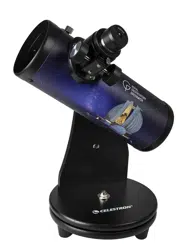Loading ...
Loading ...
Loading ...

ENGLISH | 11
Saturn is the second largest planet and a gas giant similar to
Jupiter. The planet appears yellowish due to its ammonia-rich upper
atmosphere. Like Jupiter, Saturn has very high equatorial winds
that can reach 1100 miles per hour (1800 km/h), but it lacks the
contrasting dark color bands seen on Jupiter. Sometimes large
storms can appear as white spots but can dissipate quickly.
The main thing you notice when you look at Saturn for the first time
is its incredible ring system. These rings are primarily made of small
particles of ice with traces of rocky material. They extend 75,000
miles (120,700 km) above the planet’s equator, but have an average
thickness of less than half a mile (0.8 km).
The rings were first glimpsed by Galileo Galilei in 1610 in his early
refracting telescope, but he was not able to see them clearly enough
to determine what they were. He originally thought Saturn was three
bodies orbiting closely but not touching. It was not until 1655,
that Christiaan Huygens first described their true nature as a disk
surrounding the planet. In 1675, Giovanni Domenico Cassini discovered that this disk around Saturn was actually a series
of smaller rings separated by gaps. The largest dark gap in the rings between the bright A and B rings is called the Cassini
Division in his honor. This gap spans 3000 miles (4800 km) and is visible in telescopes if the seeing conditions and ring
angle are favorable.
Roughly every 15 years, observers on Earth see Saturn’s rings completely vanish from sight. Saturn’s orbit around the
Sun is slightly inclined to Earth’s orbit. This means that twice during Saturn’s 29.5 year orbit of the Sun, Saturn’s rings are
viewed edge-on from Earth. Because the rings are so thin, they cannot be seen and all that is visible is the planet itself. The
last occurrence of this was September 4, 2009. In the years since, the angle between the Earth and Saturn has opened up,
allowing us to see a more of the rings. In 2016, the rings will once again be at their widest before slowly starting to close,
disappearing again in 2025.
Saturn has 62 confirmed moons, but only a few are visible in small telescopes. Titan, discovered by Christian Huygens in
1655, is the second largest moon in the solar system. Like Jupiter’s Ganymede, it is also larger than the planet Mercury.
The next largest moons, Rhea and Iapetus are less than 70% of the size of Titan and may be visible in telescopes as small
star-like points of light.
OBSERVING SATURN
Loading ...
Loading ...
Loading ...
